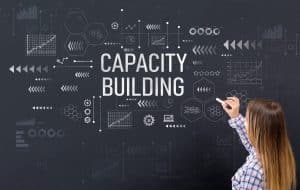Policies that Support Building Capacity to Lead Change to Advance Personalized, Competency-Based Education
Education Domain Blog

In this blog series we are exploring what it would take to move toward a future state of education that is purpose-built for student-centered learning. Moving toward a competency-based education model requires fundamental shifts in the systems, structures and assumptions that the traditional model of education is rooted in. We need bold leadership to transform K-12 education systems and policy. We need to build collaborative and distributed leadership at all levels of the education system to lead this transformation.
Human capital is a critical element of transforming K-12 education systems for the long term. The vision for students in a competency-based education system is one of empowered individuals prepared to lead their own trajectories to success in college, career and life. At the same time, we need to invest in human capital and preparing change leaders.
We need leaders at all levels who can lead the change together. We need leaders in schools, districts and states, who are willing to challenge the status quo and provide the leadership and vision for educators and communities to move ahead with new models. Policymakers could be thinking about how the state can play a role in fostering the development of a new generation of change agents and educator leaders. Local districts who are leading the way in the advancement of personalized, competency education models have the potential to play a critical role in the creation of new leadership pipelines.
There needs to be an intentional process to identify, recruit and develop leaders in the field of personalized, competency-based education. Collaboration is necessary to create competencies for educational leadership and to design development and recruitment strategies that will attract and retain a diverse cohort of next generation of education leaders. Policymakers can take up the mantle of change leader themselves, and in doing so, can engage with students, parents, and communities to collaboratively shape the vision for student success.
Jobs for the Future and the Council of Chief State School Officers created educator and leader competencies necessary to teach and lead in student-centered learning. These competencies can be used as a starting point to identify next steps in improving preparation programs, adjusting credentialing and licensure programs to allow competency-based pathways, and alternative programs that will meet the needs of the field of next generation learning.
As we explore strategies to build capacity to lead change toward a more equitable system, diversifying the teacher and leader workforce must be a core priority. To transform education, we need new perspectives about how to best design systems to help all students succeed.
Follow this blog series:
- Fit for Purpose: Taking the Long View on Systems Change and Policy to Support Competency Education
- Threshold Concept: Certifying Learning to Ensure Student Success and Career Pathways
- Issue to Tackle for Certifying Learning: Meaningful Qualifications
- Issue to Tackle for Certifying Learning: Redefining Student Success
- Threshold Concept: Building Capacity for Assessment Literacy in Personalized, Competency-Based Education
- Threshold Concept: Synchronizing K-12 Education Policy with the Learning Sciences
- Threshold Concept: Developing a Long-Term Strategy to Support Systems Change for Meeting Students Where They Are
- Accountability Models Designed for Continuous Improvement in Student-Centered Learning Systems
- Tackling Accountability as Continuous Improvement in Policy: Next Generation Accountability Models
- Building Teacher Professional Judgment in Policy to Support Competency Education
- Educator and School Leader Competencies Can Promote Systems Coherence in Competency Education
- Creating Multiple, High-Quality Pathways to Educator Credentials and Development to Support Personalized, Competency- Based Education
- Understanding How U.S. K-12 Accountability and Assessments are Too Often Conflated: What Policymakers Need to Know to Advance Student-Centered Learning Policies
Learn more:
- Report: Fit for Purpose: Taking the Long View on Systems Change and Policy to Support Competency Education
- Report: Current to Future State: Issues and Action Steps for State Policy to Support Personalized, Competency-Based Learning
- Issue Brief: Redefining Student Success: Profile of a Graduate
- Issue Brief: Redesigning Systems of Assessments for Student-Centered Learning
- Issue Brief: Rethinking State Accountability to Support Personalized, Competency-Based Learning in K-12 Education
- Issue Brief: State Strategies to Develop Teacher Capacity for Personalized, Competency-Based Learning
- Issue Brief: State Policy & K-12 Competency-Based Education
- Report: Promising State Policies for Personalized Learning
- Blog: Education Innovation Pilot Programs Provide Catalyst for Localities Personalizing Learning for K-12 Students
- National Summit on K-12 Competency-Based Education
- Follow us on social media: @nacol, @SusanDPatrick, @mariaworthen, @ntruongedu